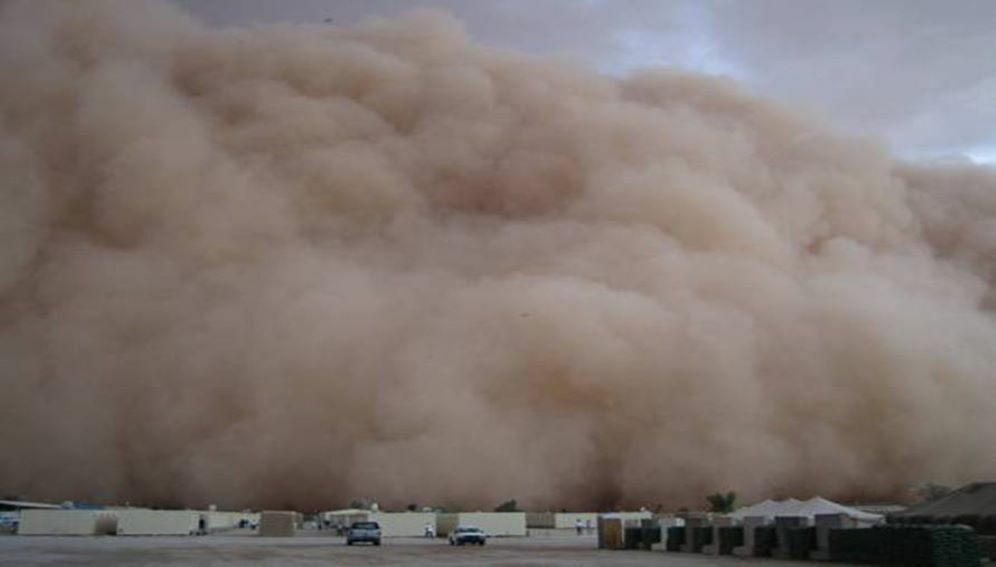05/07/22
‘Middle East cooperation needed’ to combat dust storms

Send to a friend
The details you provide on this page will not be used to send unsolicited email, and will not be sold to a 3rd party. See privacy policy.
[CAIRO] International cooperation is needed to tackle the immense dust storms that have been engulfing Middle Eastern countries, fuelled by climate change, say environmental leaders.
In the last two months, dust storms have killed 10 people and left thousands more gasping for breath in Syria, swept through 170 villages in southeastern Iran, and left many people hospitalised in Iraq and Kuwait, according to regional media reports.
The storms have caused chaos on the roads and grounded air traffic in some countries.
A memorandum of understanding was signed in early June between Iran, Iraq and Syria to try to address the extreme weather events which occur when heavy winds blow sand, dirt and other fine particles from deserts and semi-arid landscapes into urban areas.
“To reduce dust storms, everyone must cooperate.”
Hatem Hamid, director-general, National Center for Water Resources Management, Iraq
The influx of dust impairs visibility and can lead to serious respiratory problems if inhaled.
Ali Salajegheh, Iran’s vice-president and head of the Iranian Environmental Protection Organization, pointed to Iraq as one of the main sources of the dust storms affecting his country. Speaking at the signing of the memorandum, he said regional cooperation was needed to adapt to the consequences of climate change.
Kuwait and Iraq have also banded together to find solutions, but the initiative is expected to take four years to implement, according to Ali Al-Dousari, a researcher at the Environment and Life Sciences Research Center of the Kuwait Institute for Scientific Research.
Al-Dousari told SciDev.Net: “We have drawn detailed maps of the dust paths and we have noticed that their source is two areas in southern Iraq, and the soil in them can be fixed through cultivation, which is what we intend to do with the support of the Kuwait Fund for Arab Economic Development in cooperation with the Institute and the Iraqi Ministry of Agriculture.”
Planting trees in arid areas can help control dust storms but water scarcity often hinders afforestation campaigns in the Middle East.
Al-Dousari believes that the focus must be on cultivating native, drought-resistant plants, suitable for the region. He cited as an example the tamarix plant known as Torfa in Arabic, a herbal medicine traditionally used to treat conditions such as abdominal pain, hair loss, coughs, and asthma.
‘Buried alive’
Haider Najim, a journalist who lives in Baghdad, was driving home when he got caught in one of Iraq’s latest dust storms. He said it was like the sky was raining sand. “I felt as if I was getting buried alive,” he told SciDev.Net, adding that if the situation went on he would try to leave the country to avoid health repercussions.
Hatem Hamid, director-general of the National Center for Water Resources Management in Iraq, says that although dust storms are exported to other countries from the Iraqi desert, Iraq has also been the recipient of storms from Africa, Jordan, eastern Saudi Arabia and eastern Syria.
Explaining the increasing frequency and intensity of such storms, Hamid told SciDev.Net: “The lack of rain and the country’s exposure to major droughts have led to the decline of vegetation cover.
“The decrease in water revenues in the Tigris and Euphrates rivers led to a 50 per cent reduction of agricultural plains, which increased the dust storms.”
A report published in 2020 by the International Committee of the Red Cross (ICRC) entitled “When rain turns to dust” points to the role of the Iraq war in the deterioration of the environmental situation and agricultural system.
The report states that the deliberate drying of marshlands in the 1990s contributed to high temperatures, drought, desertification and rising soil salinity, as well as an increase in dust storms. The duration of storms increased from less than 25 days a year between 1951 and 1990 to about 300 days in 2013, it says.
Cross-border cooperation
The ICRC urged reform of Iraq’s water sector to support the agricultural sector as well as cross-border cooperation both within and outside the region.
Hamid stressed the need for international measures that require countries to stabilise the soil in areas where dust storms originate, by planting forests if sufficient water is available or using chemical solutions if not. “To reduce dust storms, everyone must cooperate,” he added.
A 2019 World Bank report put the cost of dust storms in the Middle East and North Africa at about US$150 billion. It advised governments to invest in early warning systems and provide fast, high-quality storm forecasts.
Amer Al-Jabri, media director of the Iraqi Meteorological Authority, told SciDev.Net: “We rely on two methods to predict storms: the first is satellite imagery, which gives a real-time report on the current status of dust storms, and the second is based on global digital forecast models available to everyone, which allows us to issue a report about 48 hours before the storm occurs.
“We do not have a prediction model of our own, but are working on obtaining a model from a French company, which is vital … to increase the accuracy of the forecast and improve its quality.”
Al-Jabri believes that the most effective way to deal with sandstorms is to increase afforestation and expand vegetation cover, as happened in Saudi Arabia in February, when the country launched a project to plant green bands to serve as buffers around the cities and purify the air entering them.















